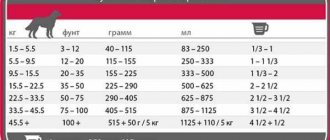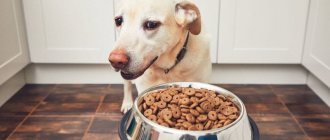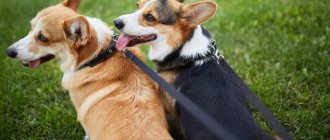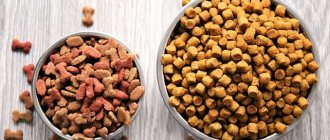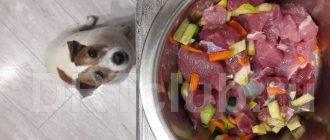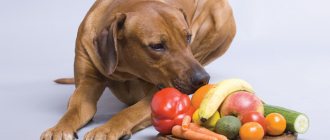Determining the amount of food for a dog
Any food manufacturer writes food standards for your pet. Based on this information, we will further calculate the norm for your dog, but do not forget that each dog is individual.
These features need to be taken into account:
Age. This is an important criterion that should not be skipped when calculating the norm.
Weight. Before making the calculation, you need to weigh your pet in order to understand whether your pet is overweight, normal, or underweight. Physical movement and activity.
Count how many times you walk your dog outside and for how long, and does your dog like active games?
Diseases. If your pet has chronic or acquired diseases, you must remember them.
Your dog's condition . If your pet has undergone treatment for any disease or is a lactating female, be sure to take this into account when calculating the amount of food and feedings.
Remember
In the tables from the manufacturer, feed standards are overestimated. The manufacturer takes the general norm for dogs, and he does not know the characteristics of your dog.
In order to choose the right food for your dog : be sure to consult a veterinarian. The doctor can suggest a better brand of food than what you sometimes choose. And one big plus is that the veterinarian knows most of the characteristics of your dog, the diseases that the pet has suffered and contraindications.
Why do you need to calculate your daily intake?
Many owners refuse to feed their pets natural food and choose ready-made food, as this is one of the most convenient and affordable ways to provide the dog with all the necessary nutrients.
Complete food is convenient because manufacturers always indicate on the packaging how much food a dog needs per day. This is very important, since there is no one universal figure for all feeds at once; this figure fluctuates depending on the composition and calorie content of the feed. Why is it important to measure dog food and why shouldn’t you rely on their appetite when determining how much to give? Dogs very often try to eat all the food available to them, since in nature their ancestors did not get prey every day. A domestic dog does not need to get its own food, but the instinct remains, and “unlimited” access to food will very quickly lead it to obesity. Therefore, every owner must strictly monitor how much food his pet eats per day.
Let us immediately note that the daily dose is usually divided into two doses and given in the morning and evening after a walk, unless we are talking about puppies or dogs with a special feeding schedule. It is recommended to remove the bowl between meals. It is also very important to remember about the drinking regime: fresh water should always be freely available.
How to choose the right food class?
To decide what kind of food you will use, you need to understand what classes of food there are and what energy value they contain:
- Economy class. Energy value is 250-300 kcal per 100 g of feed. This food consists of grains and corn. There are also undesirable components in the composition: dyes and food additives. In order for your dog to get enough of this food, you need to eat a lot of it. Such food includes the following brands: Chappie, our brand, about the tail and others. Since there are no vitamins in this food, they must be added to the dog’s diet. It is not recommended to give this food to your dog on a regular basis.
- Premium class. The energy value is higher than the previous one: 300-350 kcal per 100 grams of feed. The composition contains more than 20% protein. It is made from meat production waste. The composition is enriched with vitamins, minerals, and also contains fiber. It is necessary to take into account all the individual characteristics of your pet and if there is not enough mineral complex in the diet, then be sure to add it. This class of food includes Royal Canin and others.
- Super premium . Energy value is 360-450 kcal per 100 g of feed. This class of food is considered balanced. It practically completely replaces grains with meat, up to 75%! Another big plus of this food is that it contains a full course of vitamins and minerals necessary for a dog’s daily diet. An excellent food option for daily feeding. Brands of this class: Akana, Grandorf, etc.
And there is the last class of food - Holistic. The energy value is the same as Super-premium. There is one big difference: all food ingredients are approved for human consumption. Your pet will get maximum nutrition from this food. This class includes the Landor brand and others.
Remember! If you thought that you could add more granules and your dog would eat in economy class, you are deeply mistaken! Satiety will come when the dog eats a certain amount of calories.
When underfeeding is dangerous
During pregnancy and lactation, animals' needs for energy and nutrients increase significantly. If your pet is expecting offspring, add 25–50% to her regular diet. And when she whelps, food should not be limited at all. Leave it freely available and let the dog eat as much as he wants throughout the lactation period.
It is quite normal for a nursing bitch to eat 200% of her normal intake. Malnutrition during this energy-consuming period is fraught with a decrease in the quality of milk and loss of health for the four-legged mother. If a dog is feeding puppies, but is unable to eat large amounts of food and is clearly losing weight, it is reasonable to switch it to a higher calorie product, such as Orijen Puppy Dog, which contains 520 kcal per 120 g.
Portion volume
It is necessary to weigh the dog and find out the weight. Divide the number of kg by the number of meals. This will give you the serving size.
Food standards for puppies and adult dogs are very different. Standards for puppies are given below.
An adult dog should eat 2 times a day, and the amount of food depends on the class of food:
- Economy - 700 grams
- Premium – 500 grams
- Super-premium - 300-350 grams.
What's the difference in puppy food intake?
- There is a big difference between the amount of food for an adult pet and a small puppy.
- Puppies need to be fed little by little. The older the puppy, the fewer feedings, but the portion becomes larger.
- If your puppy is 1-2 months old, he needs to be fed 7 times a day, 100-200 grams.
- 2-3 months 6 meals of 150-200 grams.
- When the puppy is 3-4 months old, the number of meals is reduced to 5, and the portion is increased to 250-450 grams.
- The larger the puppy, the less often we feed him. At six months, your pet should eat 500-800 grams 4 times a day.
- Up to a year he has 3 times 800-1200 grams.
Feeding chart by dog weight
To independently calculate the daily amount of dry formula required for your pet, it is convenient to use a table that indicates the required amount of the product. In this case, you need to know the energy value of a particular feed.
Royal Canin
The product belongs to the super premium category and is of high quality. The mixture contains all the ingredients, vitamins and microelements required by the animal. The manufacturer offers food for all breeds of dogs, as well as for puppies, nursing bitches, old and sick pets. Royal Canin formulations should be given to the animal in strictly limited quantities. To calculate the feeding rate, use this table:
| Dog weight | Serving (g) |
| About 2 kg | 40-50 |
| 2-3 | 55-65 |
| 3-4 | 70-80 |
| 4-5 | 80-95 |
| 5-6 | 90-105 |
| 6-7 | 100-120 |
| 8 | 115-130 |
| 9 | 116-120 |
| 10 | 126-130 |
Chappie
Dry mixtures are produced by an American company. A distinctive feature of the product is its composition: Chappie contains brewer's yeast, which improves the pet's immunity. The rate of consumption of economy class mixture will depend on age, weight, lifestyle, and breed of animal. The average daily dosage can be calculated using the table provided.
| Dog weight (kg) | Daily serving (g) |
| To 10 | About 180 |
| 10-20 | Up to 350 |
| 30-40 | Up to 500 |
| 40-60 | 650 |
Brit
The company produces premium dry mixtures for different breeds, ages and sizes of dogs. It won’t be difficult to choose the right product, and to calculate the optimal daily portion, you can use the following table offered by the manufacturer:
| Animal weight (kg) | Daily feeding dosage (g) |
| To 10 | 120 |
| 10-20 | Up to 200 |
| 20-30 | Up to 270 |
| 30-40 | 330 |
Dog Chow
The product contains minerals, vitamins, oils and fats. About a quarter of the mass comes from whole grains and antioxidants, and about 15% is the meat component. Dog Chow is a high-quality, balanced premium dry product that is suitable for all breeds:
| Weight (kg) | Daily Amount (g) |
| 13-15 | 100-200 |
| 15-25 | 200-350 |
| 25-40 | 300-600 |
| 40-70 | 500-800 |
Do you need water and how much?
Every living being on our plane requires water in their diet. It helps to better absorb nutrients and forms proper metabolism. Let's look at some points that will help when calculating your daily water intake:
Weight and water intake are related. The more weight, the more water the dog needs.
For approximately 1 kg of an adult pet, 60 ml of water is needed. Puppies need to be given more water. About 80-110 ml kg weight.
If your pet only eats dry food, he needs more water.
Consider the weather conditions outside the window. If it is hot outside, change the water more often and give it in larger volumes.
Remember
Your pet's water needs to be changed several times a day. The water cup should be washed once a day to prevent plaque from forming.
Young and old
Puppies require a lot of energy to develop and grow. Calculate their daily intake based on the recommendations at the bottom of the table, or choose special products for puppies marked Puppy, where the norms are indicated by weight and breed type.
Elderly animals (over 7 years), on the contrary, are prone to obesity due to age-related slowdown of metabolism and decreased physical activity. Some Acana and Orijen lines have special dry food marked Senior, taking into account the biological needs of this particular age category. If the dog is picky about food and is accustomed to a different diet, you can stay on it, slightly reducing the usual rate.
The dog is not eating enough food, what should I do?
After your pet has eaten, does he beg for treats or food from your table? Do you think he's not getting enough food? Most often he is full. This is considered a bad dog habit that needs to be eliminated.
If you look at a dog, you can immediately understand whether it is eating or not by these criteria:
If your pet's ribs are sticking out, it means that he has lost a lot of weight and is not getting enough food. After feeding, the dog does not leave the bowl and continues to wait for his food. You can also examine the animal and determine by its fat layer whether it is receiving its daily feeding allowance or not. If the layer is thin, then no.
Important
If your pet's ribs are sticking out and you have already increased the diet, you need to contact a veterinarian; perhaps the dog is either sick or has parasites in its body.
How to make the calculation yourself
Calculating the amount of dog food yourself is quite simple and does not require much effort. To get the desired result, you need to divide the daily calorie intake by the energy value of the feed. In addition, it is worth taking into account the weight, age, activity of the pet, and the characteristics of its health. It is also recommended to consult a veterinarian.
Some manufacturers include measuring cups in the packaging
If my pet won't eat dry kibble, can I soak it in water?
- It is best to consult with your veterinarian, he will answer all your questions, taking into account the characteristics of your dog.
- There are small tips that will help you determine whether you need to do this or not. They are given below:
- If your dog likes dry food, but soaked in water. Soak it for her.
- If your pet has dental problems, soaked food will help avoid pain. It is very difficult for very small puppies to chew on such hard granules. It will be easier for them to eat soaked food.
- If you know about digestive problems or have diseases of this system, then be sure to soak with water.
Soaking the feed
If the manufacturer does not indicate restrictions on soaking the feed and such information is not on the packaging, the granules can be soaked. It is especially useful to do this for older dogs, sick individuals and puppies up to three months old.
To do this, you need to fill the granules by half or a third with unboiled drinking water, heated to about 40°C. Boiled milk is sometimes added to the puppy.
Soaked food cannot be stored for a long time - a maximum of three hours. It is dangerous to use it after longer storage, as it turns sour very quickly. Regardless of whether the dog eats dry food or soaked food, the norm is the same.
Is it possible to feed a puppy only dry food?
The gradual transfer of dog cubs to a diet of natural products or dry food begins when they are still fed on mother's milk - from three weeks of age, after the appearance of the first milk teeth.
This is interesting: Differences between the natural food diet of a puppy and an adult dog
When giving preference to industrially produced food, you should choose it from brands of at least premium class. The cheapest dog products found on store shelves have a poorly balanced composition and insufficient calorie content. Otherwise, poor nutrition can cause problems with the digestive system and allergic reactions in puppies.
Premium, super-premium and holistic foods are developed in such a way that the presence of natural food in the diet is not required, and even harmful.
The daily intake of good quality dry puppy food contains the required amount of organic substances. Additionally, vitamin-mineral complexes are not prescribed without special indications. A one-time replacement of granules with another dish - meat, porridge (mixed diet) - will create an excess of one of the beneficial compounds.
It will turn out even worse if you mix dog canned food, cereal or dishes from the master’s table with dry food: they have different digestion rates. Such actions can lead to problems with the baby’s stomach and intestines. Dogs, contrary to popular belief, do not need variety; their digestion is best tuned to processing one type of food.
With a diet consisting of dry food, it is allowed to give your pet a few treats. Their quantity should not exceed a tenth of the daily nutritional intake. Treats are offered after the main meal so as not to impair the puppy's appetite. Treats can include pieces of hard cheese, dried bread or lean meat, dog biscuits, and dried fruits.
Expert opinion
Anna Abramenko
An avid dog lover. Experience in veterinary medicine since 2009.
Ask a Question
How suitable the chosen brand of dry food is for the puppy can be judged by its appearance and well-being. The transition to another type of diet should be gradual and take several days, otherwise digestive upset may occur.
Examples of diet for puppies of different breeds
Puppies of different dog breeds also differ in weight and size. In addition, they grow and develop differently. For some, a small portion of food is enough, while others will need several times more.
Puppies of small breeds (for example, Yorkies) have an accelerated metabolism, so they mature quite quickly. Closer to a year, they can easily be switched to food for adults. Approximate calculations are described in the table.
| Adult dog weight (kg) | 2-3 | 4-6 | 7-9 | 10-13 | 14-16 | 17-19 | 20-22 | 23-25 |
| Puppy age (months) | ||||||||
| 2 | 65 | 100 | 125 | 160 | 190 | 215 | 240 | 240 |
| 3 | 70 | 110 | 145 | 190 | 225 | 255 | 295 | 295 |
| 4 | 75 | 125 | 155 | 205 | 240 | 275 | 315 | 320 |
| 5 | 75 | 125 | 155 | 205 | 245 | 280 | 325 | 335 |
| 6 | 70 | 125 | 155 | 205 | 245 | 280 | 330 | 350 |
| 7 | 60 | 110 | 140 | 185 | 230 | 260 | 325 | 350 |
| 8 | 55 | 100 | 125 | 170 | 210 | 245 | 295 | 315 |
| 9 | 90 | 110 | 150 | 195 | 225 | 265 | 285 | |
| 10 | 90 | 110 | 150 | 175 | 200 | 235 | 250 |
Large dogs (bulldogs, German shepherds, Rottweilers and the like) have a slow metabolism, so they mature later than kids. Despite the fact that the dog looks like an adult, all his organs and skeleton continue to develop, so he needs enough useful nutrients. Veterinarians often recommend giving large dogs puppy food until they reach 2 years of age. An approximate calculation is described in the table below.
| Adult dog weight (kg) | 26-29 | 30-33 | 34-37 | 38-44 | 45-54 | 55-64 | 65-74 | More than 75 |
| Puppy age (months) | ||||||||
| 2 | 255 | 245 | 260 | 295 | 380 | 395 | 415 | 440 |
| 3 | 310 | 315 | 340 | 390 | 450 | 505 | 550 | 580 |
| 4 | 345 | 355 | 390 | 435 | 490 | 555 | 615 | 645 |
| 5 | 390 | 420 | 460 | 515 | 580 | 660 | 730 | 770 |
| 6 | 435 | 460 | 525 | 590 | 655 | 750 | 835 | 880 |
| 7 | 435 | 480 | 525 | 590 | 660 | 755 | 845 | 890 |
| 8 | 405 | 445 | 490 | 585 | 655 | 755 | 850 | 895 |
| 9 | 375 | 415 | 460 | 545 | 675 | 780 | 925 | 975 |
| 10 | 345 | 380 | 430 | 510 | 660 | 765 | 910 | 960 |
| 11 | 315 | 345 | 400 | 465 | 640 | 740 | 890 | 935 |
| 12 | 375 | 425 | 625 | 720 | 860 | 905 |
These are just approximate data. The owner should monitor his pet and, if necessary, slightly reduce or increase the portion.
It is important that your dog always has clean water next to his dry food.
Food for puppies from 2–3 to 15 months
The Royal Canin food line includes food for puppies of medium, large, giant, and miniature breeds, which allows you to properly organize nutrition for your pet based on the individual needs of the body.
A unique combination of nutritional beneficial components helps normalize digestive processes (LIP proteins), normalizes the balance of intestinal microflora (prebiotics, probiotics, FOS, MOS) in puppies of different ages.
The balanced composition satisfies the energy needs of a growing body and is highly palatable for dogs.
It's all about choice
Of course, any product can cause direct or indirect harm to the dog if it is not suitable for it. It is necessary to distinguish between an individual reaction to one of the components, which can occur when feeding even the highest quality diet, and the discrepancy between the food and the needs of the dog as a whole. To solve the first problem, it is necessary to identify the component that causes the allergy or food intolerance, using an elimination diet as prescribed by a veterinarian.
In the second case, you need to know the basic principles of proper nutrition for a dog, which is a carnivore that can absorb only a limited amount of carbohydrates, which means that the basis of its diet should be meat. In accordance with this, you need to select dry food.
A diet suitable for feeding a dog should contain a sufficient amount of meat ingredients, but components such as high-carbohydrate wheat should be absent altogether. Having studied the list of dry food ingredients, you should pay attention to the first five ingredients, which make up the lion’s share of the product’s volume. The first places on the list should be animal protein sources that are listed accurately and clearly, for example, “chicken”, “turkey”, “lamb”, etc.
If you choose the right dry food that will satisfy your pet’s needs for animal products, then he will be able to eat it all his life not only without harm, but also with benefits for his health.
Feeding differences depending on breed size
Let's look at the differences in feeding depending on the size of the breed. It is not obvious to everyone that the smaller and younger the dog, the more calories it needs. Why? Let's figure it out:
- The puppy is constantly exploring the world and expending energy.
- The lower the dog, the colder the layer of air it is in, which means it spends more energy to warm itself.
- The smaller the animal, the faster its heart beats and its metabolism works.
- The more actively a dog grows, the more nutrients it requires.
Based on the above patterns, the calorie intake for a puppy is calculated as follows:
| Puppy age in months. | Kcal per day per 1 kg of body weight |
| 1–4 weeks (up to 1 month) | 210–250 |
| 1–3 | 255–280 |
| 3–4 | 195–20 |
| 4–8 | 130–156 |
| 8–12 | 100–110 |
Naturally, not only the real, but also the predicted weight of the dog is not the least important. The older the puppy needs to grow, the more actively the body “burns” proteins, and the smaller the dog’s breed, the higher the need for carbohydrates.
For adult dogs of different sizes, the relationship between calorie content and body weight is similar. When compiling a diet, you need to focus on the following standards:
| Build | Kcal per day per 1 kg of body weight |
| Miniature | 100–120 |
| Little ones | 80–90 |
| Average | 65–70 |
| Large | 60–65 |
| Gigantic | 50–60 |
How to make sure you don't make mistakes when planning your diet? The sufficient volume of a portion and calorie content can be judged by the rate of saturation and the rate of weight gain by the puppy.
If the dog does not eat the portion within 20 minutes, it is too large.
To track growth rates, the only reliable method is regular weighing. You should not rely on visual sensations, since muscle tissue is much heavier than fat, which a dog accumulates when overeating.
Small breed dogs
Small breed dogs need a nutritious, high-calorie diet. For inexperienced owners, creating a natural diet for a small dog can be a serious challenge. Most industrial food manufacturers have separate lines for small and large dogs. If you read the ingredients, you will notice that small dog food contains more artificial protein and carbohydrate substitutes.
Despite the increased calorie content, food for small dogs contains less vitamins and minerals. This feature is due to the fact that small dogs grow faster and do not need an increased supply of minerals to the body. An excess of vitamins and minerals is no less dangerous than their deficiency. Feeding small dogs unsuitable industrial products most often leads to chronic kidney disease.
Medium and large breeds
Medium and large breeds of dogs during active growth have a common weak point - the backbone. It is believed that it is better for a dog that has not reached one year of age to be “thin” than to gain a little extra weight. This statement is true because excess weight affects the formation of joints. Omissions in the preparation of a diet for a large breed puppy can result in chronic problems with the musculoskeletal system.
Many owners believe that since the dog is large, it should eat a lot. Above, we have made it clear that this statement is not true. Large and medium-sized dogs are more likely to gain excess weight because they spend less energy heating their own bodies. Gaining excess weight, in turn, can increase the load on the cardiovascular system.
